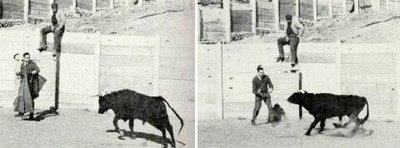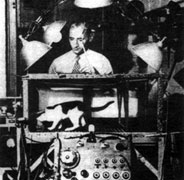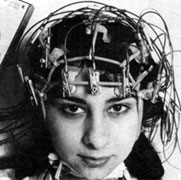 In the summer of 1953, Dr José Rodriguez Delgado stepped into the ring for the very first time in his life and confronted a charging 1,000-pound bull. Suddenly, as the horned animal lunged towards him aggressively, the bull stopped its charge and turned aside. But what really happened? Dr Delgado used a radio signal to activate an electrode implanted deep in the bull's brain, pressed a button on the transmitter and the animal obediently turned to the right and trotted away.
In the summer of 1953, Dr José Rodriguez Delgado stepped into the ring for the very first time in his life and confronted a charging 1,000-pound bull. Suddenly, as the horned animal lunged towards him aggressively, the bull stopped its charge and turned aside. But what really happened? Dr Delgado used a radio signal to activate an electrode implanted deep in the bull's brain, pressed a button on the transmitter and the animal obediently turned to the right and trotted away. The experiment took place at a bull breeding ranch in Cordoba (Spain) and was widely mentioned in popular media. “Matador with a radio stops wired bull” – wrote The New York Times the following day, and reported the event as “the most spectacular demonstration ever performed of the deliberate modification of animal behaviour through external control of the brain”. Actually, the bull was obeying commands from his brain that had been forth by electrical stimulation –by the radio signals – of certain regions in which fine wire electrodes had been painlessly implanted the day before.
The experiment took place at a bull breeding ranch in Cordoba (Spain) and was widely mentioned in popular media. “Matador with a radio stops wired bull” – wrote The New York Times the following day, and reported the event as “the most spectacular demonstration ever performed of the deliberate modification of animal behaviour through external control of the brain”. Actually, the bull was obeying commands from his brain that had been forth by electrical stimulation –by the radio signals – of certain regions in which fine wire electrodes had been painlessly implanted the day before. By that time, Doctor Delgado had been working in this feel for more than 15 years. According to NYT, he had been able to “play” monkeys and cats “like little electronic toys” that yawn, hide, fight, play, mate and go to sleep on command. Delgado began his investigation into electrically stimulated pain and pleasure in Spain during the 1930s. He later became Director of Neuropsychiatry at Yale University Medical School, where he refined the design of his remote-controlled "transdermal stimulator". Dr Delgado discovered that a whole range of emotions and behaviours can be electrically orchestrated in humans and non-human animals alike. The individual has no capacity to resist such control if stimulated.
By that time, Doctor Delgado had been working in this feel for more than 15 years. According to NYT, he had been able to “play” monkeys and cats “like little electronic toys” that yawn, hide, fight, play, mate and go to sleep on command. Delgado began his investigation into electrically stimulated pain and pleasure in Spain during the 1930s. He later became Director of Neuropsychiatry at Yale University Medical School, where he refined the design of his remote-controlled "transdermal stimulator". Dr Delgado discovered that a whole range of emotions and behaviours can be electrically orchestrated in humans and non-human animals alike. The individual has no capacity to resist such control if stimulated. One of the most curious aspects of the Delgado research is that he directed a project, in the 60's, with the help of the famous M.D., Carpenter, a specialist in monkeys and Antropoids. The project took place in Hall Island, Bermuda, and consisted of stimulating the brains of multiple monkeys that lived in the wild. These monkeys had all their movements "controlled" and "teledirected" through brain implants which registered and sent brain information to a computer.
One of the most curious aspects of the Delgado research is that he directed a project, in the 60's, with the help of the famous M.D., Carpenter, a specialist in monkeys and Antropoids. The project took place in Hall Island, Bermuda, and consisted of stimulating the brains of multiple monkeys that lived in the wild. These monkeys had all their movements "controlled" and "teledirected" through brain implants which registered and sent brain information to a computer.
After these spectacular experiments in the island, Delgado wrote: "If you insert electrodes directly into the brains of cats and apes, they will behave like electronic toys. A whole series of motor functions can be triggered based on which button the experimenter pushes. This applies to all body parts: front and back paws, the tail, the hind parts, the head, and the ears." But the most shocking projects were those in which Delgado experimented on humans, and that seem to have fallen into a strange collective amnesia. However, anyone can walk into any well-stocked American medical library and take out Delgado's own reports and articles on the subject. In an article called "Radio Control Behavior" in the February 1969, Delgado and several other colleagues describe what was the first clinical use of Intracerebral Radio Stimulation (IRS) on a human being. The stimoceiver was held fast by a bandage and all the experiments had a therapeutic goal. Fortunately they didn't go very far: "We knew too little about the brain - said Delgado years later - It is much too complicated to be controlled. We never knew which parts of the brain we were stimulating with the stimoceiver. We didn't even manage to prevent epileptic attacks, which we thought would be the simplest of things".
But the most shocking projects were those in which Delgado experimented on humans, and that seem to have fallen into a strange collective amnesia. However, anyone can walk into any well-stocked American medical library and take out Delgado's own reports and articles on the subject. In an article called "Radio Control Behavior" in the February 1969, Delgado and several other colleagues describe what was the first clinical use of Intracerebral Radio Stimulation (IRS) on a human being. The stimoceiver was held fast by a bandage and all the experiments had a therapeutic goal. Fortunately they didn't go very far: "We knew too little about the brain - said Delgado years later - It is much too complicated to be controlled. We never knew which parts of the brain we were stimulating with the stimoceiver. We didn't even manage to prevent epileptic attacks, which we thought would be the simplest of things".
For further reading: 1, 2, 3, 4, 5
How to control a charging bull with a radio transmitter
15 junio 2007
Escrito por Aberrón a las 8:03 | 0 comentarios »














